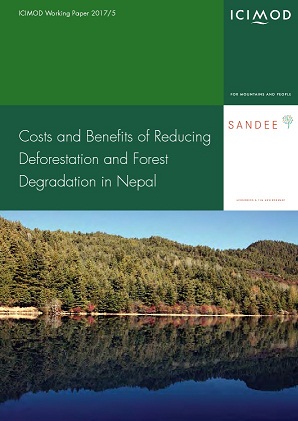Costs and benefits of reducing deforestation and forest degradation in Nepal
 The purpose of this study was to estimate the benefits and costs of reducing deforestation and forest degradation in different landscapes and management regimes in Nepal, and to provide associated opportunity costs of carbon that can be used as inputs for planning the implementation of REDD+ in Nepal. The annual cost of reducing deforestation in Nepal is between USD 654/ha and USD 3,663/ha, and the associated opportunity cost of carbon sequestration ranges from USD 1.11 to USD 3.56 per tCO2. Certain forest management regimes, such as collaborative forest management and community forestry in the Terai, follow an intensive forest management approach that emphasizes timber production. This approach falls under the framework of scientific forest management. Regimes that follow this approach involve a far lower cost of reducing deforestation compared to other forest management regimes. The cost of reducing deforestation in a degraded area is less than the cost of reducing deforestation in a forest area in an average condition (both degraded and non-degraded). The cost is between USD 557/ha and USD 2,984/ha. But the opportunity cost of carbon sequestration, which is between USD 1.30/tCO2 and USD 3.64/t
CO2, is higher in a degraded area.
The purpose of this study was to estimate the benefits and costs of reducing deforestation and forest degradation in different landscapes and management regimes in Nepal, and to provide associated opportunity costs of carbon that can be used as inputs for planning the implementation of REDD+ in Nepal. The annual cost of reducing deforestation in Nepal is between USD 654/ha and USD 3,663/ha, and the associated opportunity cost of carbon sequestration ranges from USD 1.11 to USD 3.56 per tCO2. Certain forest management regimes, such as collaborative forest management and community forestry in the Terai, follow an intensive forest management approach that emphasizes timber production. This approach falls under the framework of scientific forest management. Regimes that follow this approach involve a far lower cost of reducing deforestation compared to other forest management regimes. The cost of reducing deforestation in a degraded area is less than the cost of reducing deforestation in a forest area in an average condition (both degraded and non-degraded). The cost is between USD 557/ha and USD 2,984/ha. But the opportunity cost of carbon sequestration, which is between USD 1.30/tCO2 and USD 3.64/t
CO2, is higher in a degraded area.
